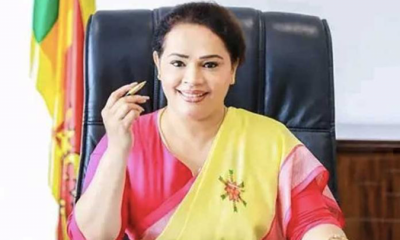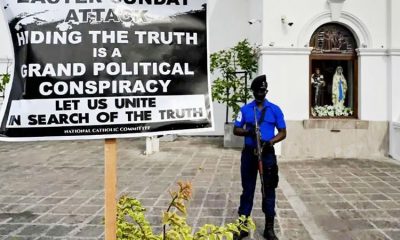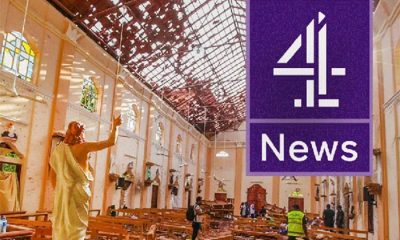Features
The Easter Sunday Attack:‘A Grand Political Plot’
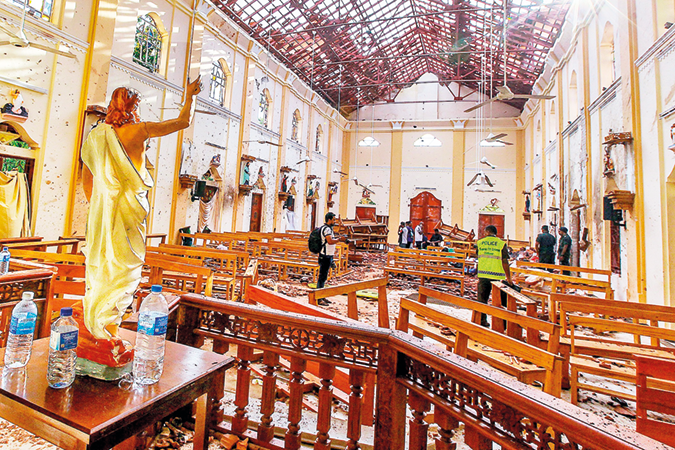
By Kingsley Wickremasuriya, PhD
E-mail: kingsley.wickremasuriya@gmail.com
Introduction
April this year marked the fourt anniversary of the Easter Sunday bomb attack which rocked and shocked Sri Lanka and the world. In retrospect, on the morning of that fateful Easter Sunday, April 21, 2019 suicide bombers targeted three plush hotels and three churches in Colombo, Negombo, and Batticaloa; over 260 were killed and over 500 injured in the well-coordinated near-simultaneous attacks by a group of Islamic extremists called the National Thawheek Jamaat allegedly subscribing to Islamic ideology of JIHAD associated with group with suspected foreign links, that has previously targeted and
Two of the three churches attacked were Catholic churches. One was St. Anthony’s Church in Kochchikade, Colombo, and the other was St. Sebastian’s Church in Katuwapitiya, Negombo. The third church under attack was the Protestant evangelical Zion Church in Batticaloa. The attacks affected the Catholic Church in Sri Lanka directly as many of the victims were Catholics.
The three hotels targeted were the Shangri-La, Kingsbury, and Cinnamon Grand in Colombo. Several of the victims were foreign nationals. Two other persons connected to the Islamic Jihad Movement were killed in two separate explosions in Dehiwala and Dematagoda. Most of the innocents killed, maimed, and injured were people engaged in morning worship at the churches or guests having breakfast in the hotels.
Shortly afterward, , a propaganda outlet for the Islamic State of Iraq and the Levant (ISIL), claimed that ISIL inspired the attacks. It released a photo and a video showing eight suicide bombers pledging allegiance to ISIL leader . Zahran Hashim of the NTJ was identified as their leader.
On April 6, Public Security Minister Sarath Weerasekara stated at a press conference that the Intelligence Services had identified Naufer Moulavi as the mastermind behind the attacks. The Minister also said that he was then in remand custody. Making a special statement in Parliament on April 10, he confirmed his statement to the press that Naufer Moulavi was the main person behind the Easter Sunday terror attacks. Following these disclosures, the national and international media went to town with the revelation that the Sri Lankan Government Minister had identified Naufer Moulavi as the mastermind behind the attack.
State Defense Minister , however, had said earlier, that initial investigations have revealed that Islamic extremists “carried out the attacks in retaliation for the ,’’ a place far removed from the scene of the explosion here. This has been questioned by New Zealand’s Prime Minister and by other experts, who saw the Easter attacks as planned before the Christchurch incident. Further, the New Zealand security expert Paul Buchanan stated that “Christchurch seems to be a convenient justification for something that was being planned before March 15”.
The Amaq news agency’s statements emphasized that the attacks were against Christians who were at war with the organization but none of them referenced the Christchurch incident. But Sri Lanka was not part of the anti-ISIL coalition and the overwhelming majority of those killed in the bombings were Sri Lankan citizen. Further, according to the Criminal Investigation Department, there was no evidence of ISIL’s direct involvement. It was evident that Tawheed Jamaat has been stockpiling explosives since January 2019. Even though it was claimed that the incident was inspired by ISIL, the available evidence was to the contrary.
Meanwhile, Malcolm Cardinal , the head of Sri Lanka’s Catholic Church, alleged that the massacre wasn’t purely the work of a few Islamic extremists but was part of a grand political plot, and that the attacks were conducted intentionally to win votes. He further alleged that the culprits are still holding high positions in the police and Military Intelligence and that the government has been covering up the investigations to protect the real culprits. Expressing dissatisfaction with the progress of the investigation and alleging intimidation of those who clamor for justice, the cardinal called on the UN to investigate the bombings. Even some prominent Buddhist monks contributed to this theory and alleged that “selfish politicians directed the blind rage of religious extremists to achieve political ends”.
Quoting from the report of the President’s Commission on the attack, chapter and verse, in support of his allegation, His Eminence pointed the finger at the former chief of intelligence, and other top-level officials including the Police, for their failure to prevent the attacks. ‘They knew beforehand from the information they had gathered and also from warnings given by the Indian intelligence services, but they did nothing. The Government seems to have done its best to prevent the arrest of the attackers. There are indications that the authorities wanted the attacks to be carried out, he alleged.
Quoting further excerpts from the Presidential Commission Report and other authentic sources, he said that the available evidence indicates that the Government may have been motivated by electoral gain. While Cardinal was making these allegations, Rev. Father Cyril Gamini, spokesman for the Committee of Catholics pointed out several issues regarding some serious lapses in the investigations in a telecast over ‘You Tube’. He also based his arguments on authentic sources like the proceedings of the Presidential Commission and the Parliamentary Select Committee.
These arguments were buttressed by the Opposition in the Parliament during a parliamentary debate on the appointment of a Select Committee on the attack suggesting that it was the work of a Special Operation of an Intelligence Service. Besides, the fact that the former Attorney – General is on record having said that there is a conspiracy behind the incident goes to add further weight against those who the allegations have been made against.
Call for justice
It is against this backdrop that the Cardinal has been repeatedly demanding justice for the victims and their families for a long time. In March this year, he issued what was termed by the media as an ultimatum to the government. The news story stated that the ‘Archbishop of Colombo Malcolm Cardinal Ranjith yesterday warned that countrywide protests would be held if the Government failed to produce before Courts by April 21, those behind the Easter Sunday attacks. “We urge the Government to investigate the attacks impartially and transparently. At least take action against those named in the Presidential Commission on Easter Sunday attacks before April 21. Otherwise, we will hold a continuous protest,” the Cardinal warned. Going by the turn of events, the Cardinal is not likely to rest until the ‘true masterminds’ behind the carnage are identified and penalized.
Conclusions
The incident reveals serious criminal offenses committed against the State putting its security in jeopardy. The offenses of this nature are punishable under the ‘offences against the state’ specified in chapter VI of the Penal Code. It covers a range of offenses relevant to the incident, including conspiracy, abetting and concealment. These offenses carry punishments from death, or imprisonment of either description, which may be extended to 20 years, and the forfeiture of the offender’s property.
But one has to admit that the offenders can be brought to justice only after a fair and impartial criminal investigation and thereafter arraignment before a court of law after a fair trial in keeping with the Rule of Law. That is what the aggrieved parties have been clamoring for. However, from the material exposed so far it appears that the criminal investigations have been obstructed at several points down the line.
Names of several high-ranking officers in the Police and State Intelligence Services have transpired during the course of the Presidential Commission, Select Committee proceedings, debates in Parliament and elsewhere in the Press and Media. Allegations have been made against them by the Church authorities and the aggrieved parties. But these accusations or allegations have not been processed through the criminal justice system. As far as the country is concerned, they have broken the sacred trust the country placed in them.
Presidential Commissions or Select Committees, will not help to clear the air. They will, whatever the picture their sponsors might try to paint to exculpate them, therefore, remain ’guilty’ in the national conscience. As such if they continue to hold those high positions without being cleared through the criminal justice system their credibility will be at stake. They will be watched by the Nation at every move they make with suspicion that will make them vulnerable in their own commands.
Moreover, the attack has all the characteristics of a Special Operation conducted by an Intelligence organization. But without a proper investigation one cannot prove, who is responsible; whether it is the work of a foreign intelligence service or our own or a combination of both.
It has been said that among the growing arsenals across the world, intelligence is an essential weapon, perhaps the most important, and that intelligence is necessary for democracies to avoid disaster and possibly destruction. In other words, ‘Intelligence Organizations are an inevitable part of modern states as armies, telephones, and postal services or a system of collecting taxes’.
Intelligence Organizations have now come to play an ever-increasingly important role. They are a part of the defense forces of a country. Their task is the defense of the realm as a whole from external and internal threats arising from attempts at espionage and sabotage or from actions of persons and organizations whether directed from within or without the country that may be considered subversive of the state’s security. They not only act as the eyes and ears of governments but also as their policy instruments.
One must therefore, accept that intelligence organizations are a reality in modern National and International life in a world that is no longer ruled by ‘negotiation between gentlemen, but rather by plots, revolutions, conspiracies, assassinations, coups d’états, and general mayhem. As such there is an inherent danger within the system itself.
Firstly, intelligence organizations can misinform their governments by providing false information, because the information has been planted on them by a hostile service through a double agent; a sycophantic Intelligence Organization believes that it should provide information that its Masters want to hear; that it has become a representative of a vested interest; and that the Service is thoroughly incompetent that it invents its information and create a non-existent source to cover up its failure. This danger is increased substantially where the Intelligence Organizations control paramilitary forces. They can be real dangers to their states because they represent or can represent conspiratorial power points
Intelligence services are specially trained to carry out covert operations while on the other hand the main task of the Police is the prevention of crimes and offenses. Therefore, it is unimaginable to find any State Intelligence Service or the Police working in concert with subversives against the grain of their basic responsibilities under the very nose of the State. This is why it is doubly important not to have any doubts left as to who was responsible for the attack and who the mastermind behind was.
The trade of intelligence, therefore, is not everyone’s cup of tea.
Intelligence Organizations, should be highly professional and their management should, be in the hands of men of first-rate ability, imagination, and integrity. In the last analysis, however, the truth is that the intelligence organizations are as competent or incompetent as the governments who control them.
Features
The heart-friendly health minister
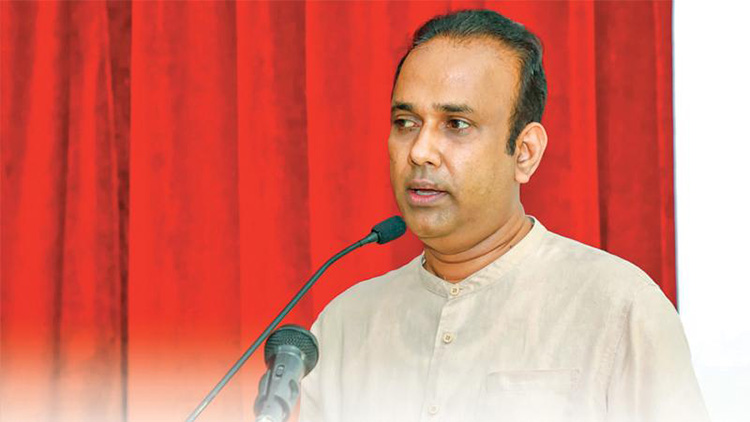
by Dr Gotabhya Ranasinghe
Senior Consultant Cardiologist
National Hospital Sri Lanka
When we sought a meeting with Hon Dr. Ramesh Pathirana, Minister of Health, he graciously cleared his busy schedule to accommodate us. Renowned for his attentive listening and deep understanding, Minister Pathirana is dedicated to advancing the health sector. His openness and transparency exemplify the qualities of an exemplary politician and minister.
Dr. Palitha Mahipala, the current Health Secretary, demonstrates both commendable enthusiasm and unwavering support. This combination of attributes makes him a highly compatible colleague for the esteemed Minister of Health.
Our discussion centered on a project that has been in the works for the past 30 years, one that no other minister had managed to advance.
Minister Pathirana, however, recognized the project’s significance and its potential to revolutionize care for heart patients.
The project involves the construction of a state-of-the-art facility at the premises of the National Hospital Colombo. The project’s location within the premises of the National Hospital underscores its importance and relevance to the healthcare infrastructure of the nation.
This facility will include a cardiology building and a tertiary care center, equipped with the latest technology to handle and treat all types of heart-related conditions and surgeries.
Securing funding was a major milestone for this initiative. Minister Pathirana successfully obtained approval for a $40 billion loan from the Asian Development Bank. With the funding in place, the foundation stone is scheduled to be laid in September this year, and construction will begin in January 2025.
This project guarantees a consistent and uninterrupted supply of stents and related medications for heart patients. As a result, patients will have timely access to essential medical supplies during their treatment and recovery. By securing these critical resources, the project aims to enhance patient outcomes, minimize treatment delays, and maintain the highest standards of cardiac care.
Upon its fruition, this monumental building will serve as a beacon of hope and healing, symbolizing the unwavering dedication to improving patient outcomes and fostering a healthier society.We anticipate a future marked by significant progress and positive outcomes in Sri Lanka’s cardiovascular treatment landscape within the foreseeable timeframe.
Features
A LOVING TRIBUTE TO JESUIT FR. ALOYSIUS PIERIS ON HIS 90th BIRTHDAY

by Fr. Emmanuel Fernando, OMI
Jesuit Fr. Aloysius Pieris (affectionately called Fr. Aloy) celebrated his 90th birthday on April 9, 2024 and I, as the editor of our Oblate Journal, THE MISSIONARY OBLATE had gone to press by that time. Immediately I decided to publish an article, appreciating the untiring selfless services he continues to offer for inter-Faith dialogue, the renewal of the Catholic Church, his concern for the poor and the suffering Sri Lankan masses and to me, the present writer.
It was in 1988, when I was appointed Director of the Oblate Scholastics at Ampitiya by the then Oblate Provincial Fr. Anselm Silva, that I came to know Fr. Aloy more closely. Knowing well his expertise in matters spiritual, theological, Indological and pastoral, and with the collaborative spirit of my companion-formators, our Oblate Scholastics were sent to Tulana, the Research and Encounter Centre, Kelaniya, of which he is the Founder-Director, for ‘exposure-programmes’ on matters spiritual, biblical, theological and pastoral. Some of these dimensions according to my view and that of my companion-formators, were not available at the National Seminary, Ampitiya.
Ever since that time, our Oblate formators/ accompaniers at the Oblate Scholasticate, Ampitiya , have continued to send our Oblate Scholastics to Tulana Centre for deepening their insights and convictions regarding matters needed to serve the people in today’s context. Fr. Aloy also had tried very enthusiastically with the Oblate team headed by Frs. Oswald Firth and Clement Waidyasekara to begin a Theologate, directed by the Religious Congregations in Sri Lanka, for the contextual formation/ accompaniment of their members. It should very well be a desired goal of the Leaders / Provincials of the Religious Congregations.
Besides being a formator/accompanier at the Oblate Scholasticate, I was entrusted also with the task of editing and publishing our Oblate journal, ‘The Missionary Oblate’. To maintain the quality of the journal I continue to depend on Fr. Aloy for his thought-provoking and stimulating articles on Biblical Spirituality, Biblical Theology and Ecclesiology. I am very grateful to him for his generous assistance. Of late, his writings on renewal of the Church, initiated by Pope St. John XX111 and continued by Pope Francis through the Synodal path, published in our Oblate journal, enable our readers to focus their attention also on the needed renewal in the Catholic Church in Sri Lanka. Fr. Aloy appreciated very much the Synodal path adopted by the Jesuit Pope Francis for the renewal of the Church, rooted very much on prayerful discernment. In my Religious and presbyteral life, Fr.Aloy continues to be my spiritual animator / guide and ongoing formator / acccompanier.
Fr. Aloysius Pieris, BA Hons (Lond), LPh (SHC, India), STL (PFT, Naples), PhD (SLU/VC), ThD (Tilburg), D.Ltt (KU), has been one of the eminent Asian theologians well recognized internationally and one who has lectured and held visiting chairs in many universities both in the West and in the East. Many members of Religious Congregations from Asian countries have benefited from his lectures and guidance in the East Asian Pastoral Institute (EAPI) in Manila, Philippines. He had been a Theologian consulted by the Federation of Asian Bishops’ Conferences for many years. During his professorship at the Gregorian University in Rome, he was called to be a member of a special group of advisers on other religions consulted by Pope Paul VI.
Fr. Aloy is the author of more than 30 books and well over 500 Research Papers. Some of his books and articles have been translated and published in several countries. Among those books, one can find the following: 1) The Genesis of an Asian Theology of Liberation (An Autobiographical Excursus on the Art of Theologising in Asia, 2) An Asian Theology of Liberation, 3) Providential Timeliness of Vatican 11 (a long-overdue halt to a scandalous millennium, 4) Give Vatican 11 a chance, 5) Leadership in the Church, 6) Relishing our faith in working for justice (Themes for study and discussion), 7) A Message meant mainly, not exclusively for Jesuits (Background information necessary for helping Francis renew the Church), 8) Lent in Lanka (Reflections and Resolutions, 9) Love meets wisdom (A Christian Experience of Buddhism, 10) Fire and Water 11) God’s Reign for God’s poor, 12) Our Unhiddden Agenda (How we Jesuits work, pray and form our men). He is also the Editor of two journals, Vagdevi, Journal of Religious Reflection and Dialogue, New Series.
Fr. Aloy has a BA in Pali and Sanskrit from the University of London and a Ph.D in Buddhist Philosophy from the University of Sri Lankan, Vidyodaya Campus. On Nov. 23, 2019, he was awarded the prestigious honorary Doctorate of Literature (D.Litt) by the Chancellor of the University of Kelaniya, the Most Venerable Welamitiyawe Dharmakirthi Sri Kusala Dhamma Thera.
Fr. Aloy continues to be a promoter of Gospel values and virtues. Justice as a constitutive dimension of love and social concern for the downtrodden masses are very much noted in his life and work. He had very much appreciated the commitment of the late Fr. Joseph (Joe) Fernando, the National Director of the Social and Economic Centre (SEDEC) for the poor.
In Sri Lanka, a few religious Congregations – the Good Shepherd Sisters, the Christian Brothers, the Marist Brothers and the Oblates – have invited him to animate their members especially during their Provincial Congresses, Chapters and International Conferences. The mainline Christian Churches also have sought his advice and followed his seminars. I, for one, regret very much, that the Sri Lankan authorities of the Catholic Church –today’s Hierarchy—- have not sought Fr.
Aloy’s expertise for the renewal of the Catholic Church in Sri Lanka and thus have not benefited from the immense store of wisdom and insight that he can offer to our local Church while the Sri Lankan bishops who governed the Catholic church in the immediate aftermath of the Second Vatican Council (Edmund Fernando OMI, Anthony de Saram, Leo Nanayakkara OSB, Frank Marcus Fernando, Paul Perera,) visited him and consulted him on many matters. Among the Tamil Bishops, Bishop Rayappu Joseph was keeping close contact with him and Bishop J. Deogupillai hosted him and his team visiting him after the horrible Black July massacre of Tamils.
Features
A fairy tale, success or debacle

Sri Lanka-Singapore Free Trade Agreement
By Gomi Senadhira
senadhiragomi@gmail.com
“You might tell fairy tales, but the progress of a country cannot be achieved through such narratives. A country cannot be developed by making false promises. The country moved backward because of the electoral promises made by political parties throughout time. We have witnessed that the ultimate result of this is the country becoming bankrupt. Unfortunately, many segments of the population have not come to realize this yet.” – President Ranil Wickremesinghe, 2024 Budget speech
Any Sri Lankan would agree with the above words of President Wickremesinghe on the false promises our politicians and officials make and the fairy tales they narrate which bankrupted this country. So, to understand this, let’s look at one such fairy tale with lots of false promises; Ranil Wickremesinghe’s greatest achievement in the area of international trade and investment promotion during the Yahapalana period, Sri Lanka-Singapore Free Trade Agreement (SLSFTA).
It is appropriate and timely to do it now as Finance Minister Wickremesinghe has just presented to parliament a bill on the National Policy on Economic Transformation which includes the establishment of an Office for International Trade and the Sri Lanka Institute of Economics and International Trade.
Was SLSFTA a “Cleverly negotiated Free Trade Agreement” as stated by the (former) Minister of Development Strategies and International Trade Malik Samarawickrama during the Parliamentary Debate on the SLSFTA in July 2018, or a colossal blunder covered up with lies, false promises, and fairy tales? After SLSFTA was signed there were a number of fairy tales published on this agreement by the Ministry of Development Strategies and International, Institute of Policy Studies, and others.
However, for this article, I would like to limit my comments to the speech by Minister Samarawickrama during the Parliamentary Debate, and the two most important areas in the agreement which were covered up with lies, fairy tales, and false promises, namely: revenue loss for Sri Lanka and Investment from Singapore. On the other important area, “Waste products dumping” I do not want to comment here as I have written extensively on the issue.
1. The revenue loss
During the Parliamentary Debate in July 2018, Minister Samarawickrama stated “…. let me reiterate that this FTA with Singapore has been very cleverly negotiated by us…. The liberalisation programme under this FTA has been carefully designed to have the least impact on domestic industry and revenue collection. We have included all revenue sensitive items in the negative list of items which will not be subject to removal of tariff. Therefore, 97.8% revenue from Customs duty is protected. Our tariff liberalisation will take place over a period of 12-15 years! In fact, the revenue earned through tariffs on goods imported from Singapore last year was Rs. 35 billion.
The revenue loss for over the next 15 years due to the FTA is only Rs. 733 million– which when annualised, on average, is just Rs. 51 million. That is just 0.14% per year! So anyone who claims the Singapore FTA causes revenue loss to the Government cannot do basic arithmetic! Mr. Speaker, in conclusion, I call on my fellow members of this House – don’t mislead the public with baseless criticism that is not grounded in facts. Don’t look at petty politics and use these issues for your own political survival.”
I was surprised to read the minister’s speech because an article published in January 2018 in “The Straits Times“, based on information released by the Singaporean Negotiators stated, “…. With the FTA, tariff savings for Singapore exports are estimated to hit $10 million annually“.
As the annual tariff savings (that is the revenue loss for Sri Lanka) calculated by the Singaporean Negotiators, Singaporean $ 10 million (Sri Lankan rupees 1,200 million in 2018) was way above the rupees’ 733 million revenue loss for 15 years estimated by the Sri Lankan negotiators, it was clear to any observer that one of the parties to the agreement had not done the basic arithmetic!
Six years later, according to a report published by “The Morning” newspaper, speaking at the Committee on Public Finance (COPF) on 7th May 2024, Mr Samarawickrama’s chief trade negotiator K.J. Weerasinghehad had admitted “…. that forecasted revenue loss for the Government of Sri Lanka through the Singapore FTA is Rs. 450 million in 2023 and Rs. 1.3 billion in 2024.”
If these numbers are correct, as tariff liberalisation under the SLSFTA has just started, we will pass Rs 2 billion very soon. Then, the question is how Sri Lanka’s trade negotiators made such a colossal blunder. Didn’t they do their basic arithmetic? If they didn’t know how to do basic arithmetic they should have at least done their basic readings. For example, the headline of the article published in The Straits Times in January 2018 was “Singapore, Sri Lanka sign FTA, annual savings of $10m expected”.
Anyway, as Sri Lanka’s chief negotiator reiterated at the COPF meeting that “…. since 99% of the tariffs in Singapore have zero rates of duty, Sri Lanka has agreed on 80% tariff liberalisation over a period of 15 years while expecting Singapore investments to address the imbalance in trade,” let’s turn towards investment.
Investment from Singapore
In July 2018, speaking during the Parliamentary Debate on the FTA this is what Minister Malik Samarawickrama stated on investment from Singapore, “Already, thanks to this FTA, in just the past two-and-a-half months since the agreement came into effect we have received a proposal from Singapore for investment amounting to $ 14.8 billion in an oil refinery for export of petroleum products. In addition, we have proposals for a steel manufacturing plant for exports ($ 1 billion investment), flour milling plant ($ 50 million), sugar refinery ($ 200 million). This adds up to more than $ 16.05 billion in the pipeline on these projects alone.
And all of these projects will create thousands of more jobs for our people. In principle approval has already been granted by the BOI and the investors are awaiting the release of land the environmental approvals to commence the project.
I request the Opposition and those with vested interests to change their narrow-minded thinking and join us to develop our country. We must always look at what is best for the whole community, not just the few who may oppose. We owe it to our people to courageously take decisions that will change their lives for the better.”
According to the media report I quoted earlier, speaking at the Committee on Public Finance (COPF) Chief Negotiator Weerasinghe has admitted that Sri Lanka was not happy with overall Singapore investments that have come in the past few years in return for the trade liberalisation under the Singapore-Sri Lanka Free Trade Agreement. He has added that between 2021 and 2023 the total investment from Singapore had been around $162 million!
What happened to those projects worth $16 billion negotiated, thanks to the SLSFTA, in just the two-and-a-half months after the agreement came into effect and approved by the BOI? I do not know about the steel manufacturing plant for exports ($ 1 billion investment), flour milling plant ($ 50 million) and sugar refinery ($ 200 million).
However, story of the multibillion-dollar investment in the Petroleum Refinery unfolded in a manner that would qualify it as the best fairy tale with false promises presented by our politicians and the officials, prior to 2019 elections.
Though many Sri Lankans got to know, through the media which repeatedly highlighted a plethora of issues surrounding the project and the questionable credentials of the Singaporean investor, the construction work on the Mirrijiwela Oil Refinery along with the cement factory began on the24th of March 2019 with a bang and Minister Ranil Wickremesinghe and his ministers along with the foreign and local dignitaries laid the foundation stones.
That was few months before the 2019 Presidential elections. Inaugurating the construction work Prime Minister Ranil Wickremesinghe said the projects will create thousands of job opportunities in the area and surrounding districts.
The oil refinery, which was to be built over 200 acres of land, with the capacity to refine 200,000 barrels of crude oil per day, was to generate US$7 billion of exports and create 1,500 direct and 3,000 indirect jobs. The construction of the refinery was to be completed in 44 months. Four years later, in August 2023 the Cabinet of Ministers approved the proposal presented by President Ranil Wickremesinghe to cancel the agreement with the investors of the refinery as the project has not been implemented! Can they explain to the country how much money was wasted to produce that fairy tale?
It is obvious that the President, ministers, and officials had made huge blunders and had deliberately misled the public and the parliament on the revenue loss and potential investment from SLSFTA with fairy tales and false promises.
As the president himself said, a country cannot be developed by making false promises or with fairy tales and these false promises and fairy tales had bankrupted the country. “Unfortunately, many segments of the population have not come to realize this yet”.
(The writer, a specialist and an activist on trade and development issues . )




